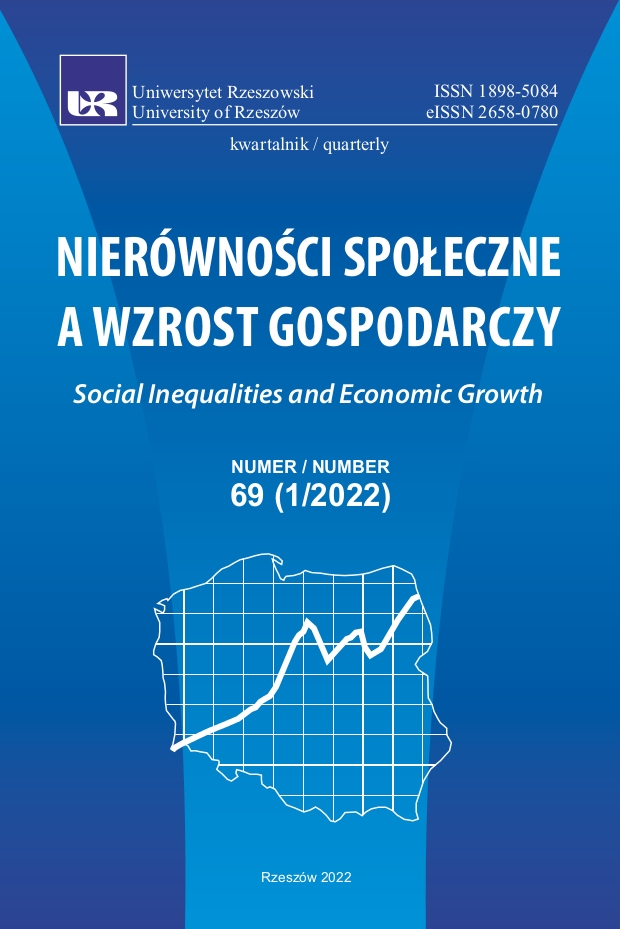Change in the level of socio-economic development in Poland in the subregional dimension
DOI:
https://doi.org/10.15584/nsawg.2022.1.1Keywords:
synthetic gap, provinces, distance from the role model, Hellwig’s reductionAbstract
The compilation involved an analysis of the level of socioeconomic development at the NUTS-3 subregion level in Poland, based on 60 indicators classified within 4 subcomponents (factors) of regional development: material capital, human capital, natural environment and both innovativeness and entrepreneurship. The purpose of the article is to present the varied nature of the socio-economic level of development in Poland based on the NUTS-3 subregion concept. The level of socioeconomic development, as well as the level of its shaping factors, is presented based on a synthetic gap exhibiting the taxonomic distance of a particular subregion in terms of the established pattern of development. The examination was carried out in the static dimension (based on the values of the indicators in 2019) as well as in parallel with the dynamic dimension (based on changes in the values of the gaps in the years 2010–2019). In the compilation, a hypothesis which was tested according to which the socio-economic development of the subregions in Poland is highly varied, and its highest level is registered in the largest provincial cities: Warsaw, Cracow, Wrocław and Poznań, and the lowest in the subregions far away from these major cities, which constitute the centers of development.
Downloads
References
Churski, P. (2008). Czynniki rozwoju regionalnego i polityka regionalna w Polsce w okresie integracji z Unią Europejską. Poznań: Wydawnictwo Naukowe UAM.
Dattorro, J. (2005). Convex Optimization & Euclidean Distance Geometry. USA: Meboo Publishing.
Główny Urząd Statystyczny. (2020). Bank Danych Lokalnych. Retrieved from: http://stat.gov.pl/bdl/ (2020.12.15).
Grosse, T. G. (2004). Poland and the EU new cohesion policy. Warszawa: Instytut Spraw Publicznych.
Hall, R. (2012). European Union Regional Policy Aims, Methods, Results and...Reform. Brussels: European Commission.
Hartigan, J. A. (1975). Clustering Algorithms. New York: J. Wiley.
Hellwig, Z. (1990). Taksonometria ekonomiczna, jej osiągnięcia, zadania i cele. Kraków: Wydawnictwo Akademii Ekonomicznej w Krakowie.
Iyer, S., Kitson, M., and Toh, B. (2005). Social capital, economic growth and regional development. Regional Studies, 8, 1015–1040. DOI:10.1080/00343400500327943.
Kehagia, A. (2013). The Impact of the EU’s Structural and Cohesion Funds. Jean Monnet Papers on Political Economy, 6, 2–26.
Kološta, S. (2016). Učiaci sa región – východiská, podstata, kritika, využitie. Banská Bystrica: Univerzity Mateja Bela v Banskej Bystrici.
Kordos, J., Paradysz, J. (1999). Some experiments in small area estimation in Poland. Riga: International Association of Survey Statisticians.
Kozarova, I. (2013). The impact of driving forces of globalization on the nature of border effects in Slovakia. In: L. Krticka (Ed.), Political factors of economic growth and development in transition economies (pp. 78–89). Ostrava: University of Ostrava.
Krugman, P. (1991). Increasing returns and economic geography. Journal of Political Economy, 99(3), 483–499. DOI:10.1086/261763.
Martin, R. (2010). Regional economic resilience, hysteresis and recessionary shocks.
Journal of Economic Geography, 12(1), 1–32. DOI:10.1093/jeg/lbr019.
Nowak, E. (1990). Metody taksonomiczne w klasyfikacji obiektów społeczno-gospodarczych. Warszawa: Państwowe Wydawnictwo Ekonomiczne.
Spychała, M. (2017). Zróżnicowanie przestrzenne absorpcji funduszy unijnych perspektywy finansowej 2007–2013 a zmiany poziomu wzrostu gospodarczego województw w Polsce. Nierówności Społeczne a Wzrost Gospodarczy, 49(1), 348–358. DOI: 10.15584/nsawg.2017.1.26.
Spychała, M. (2020a). Spatial differentiation in the EU fund absorption in Poland – a regional outlook. Scientific Papers of Silesian University of Technology – Organization and Management Series, 146, 455–468. DOI: 10.29119/1641-3466.2020.146.32.
Spychała, M. (2020b). The absorption of EU funds and the socio-economic development in the subregional dimension in Poland. Research Papers of Wrocław University of Economics, 64(3), 78–91. DOI: 10.15611/pn.2020.3.07.
Stiglitz, J. E. (2004). Globalizacja. Warszawa: Wydawnictwo Naukowe PWN.
Sweet, D. (2012). EU Cohesion Policy 2014–2020. Brussels: European Commission.
Downloads
Published
How to Cite
Issue
Section
License

This work is licensed under a Creative Commons Attribution-ShareAlike 4.0 International License.


